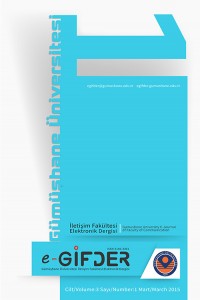Abstract
In this study, the role of television on people's perceptions of the world and their conceptualizations of social reality is examined in the context of George Gerbner's Cultivation Theory. In this scope, a survey has been carried out using Cultivation Analysis, which is one of the three components of the Cultural Indicators Project along with Institutional Process Analysis and Message System Analysis. As a result of the survey carried out at Anadolu University, Faculty of Sciences with 262 students from various departments, it has been determined that the television has performed its cultivation role on the basis of "It is dangerous to walk alone at night" and "People cannot be trusted in our day"
Keywords
References
- BATMAZ, Veysel; AKSOY, Asu (1995). Türkiye’de Televizyon ve Aile, Ankara: T.C. Başbakanlık Aile Araştırma Kurumu.
- GERBNER, George (1959). “Education and The Challange of Mass Culture”, AV Communication Review. Vol: 7, Page: 264-278.
- GERBNER, George (1963). “Communication and The Humanization of Homo Sapiens”, AAUW Journal. Vol: 56, Page: 102-104.
- GERBNER, George (1966a). An Institutional Approach to Mass Communications Research, (Editor), Lee Thayer. Communication: Theory and Research, Springfield: Charles C. Thomas, s. 429-445.
- GERBNER, George (1966b). Images Across Cultures: Teachers in Mass Media Fiction and Drama”, The School Review. Vol: 74, Page: 212-229.
- GERBNER, George (1967). Mass Media and Human Communication Theory, (Editor), Frank E. X. Dance. Human Communication Theory: Original Essays, New York: Hot, Rinehart & Winston, s. 40-60.
- GERBNER, George (1974). “Communication: Society is The Message”, Communication. Vol: 1, Page: 57-64.
- GERBNER, George (1985). Mass Media Discourse: Message System Analysis As A Component of Cultural Indicators, (Editor), Teun A. van Dijk. Discourse and Communication: New Approaches to The Analysis of Mass Media Discourse and Communication, Berlin: Walter de Guyter & Co, s. 13-25.
- GERBNER, George (1996). Foreword: Invassion of The Story Sellers, Roy F. Fox. Harvesting Minds: How TV Commercials Control Kids, Westport: Praeger, s. ix-xiii.
- GERBNER, George (2000). “Cultivation Analysis: An Overview”, Mass Communication & Society. Vol: 1, Page: 3-12.
- MORGAN, Michael (1995). The Critical Contrubution of George Gerbner, (Editor), John A. Lent. A Different Road Taken, New York: Westview Press, s. 99- 117.
- ÖZER, Ömer (2004). Yetiştirme Kuramı: Televizyonun Kültürel İşlevlerinin İncelenmesi, Eskişehir: Anadolu Üniversitesi Yayınları.
- ÖZER, Ömer (2005). “Televizyonun Yetiştirme Rolü: Ankara Çevik Kuvvet Örneği”, Gazi Üniversitesi İletişim Dergisi, Bahar/Kış 2005, Sayı: 20, 1-20.
- ÖZER, Ömer (2007). Medya, Şiddet, Toplum, Eskişehir: Anadolu Üniversitesi Yayınları.
- SHANAHAN, James; MORGAN, Michael (1999). Television and Its Viewers: Cultivation Theory and Research, Cambridge: Cambridge University Press.
Abstract
Bu çalışmada, George Gerbner’ın Yetiştirme Kuramı odağında, insanların dünya algılamaları ve sosyal gerçeklik kavramsallaştırmalarına ilişkin televizyonun rolü ele alınmıştır. Bu kapsamda, Kültürel Göstergeler Projesi’nin Kurumsal Süreç Çözümlemesi, Mesaj Sistem Çözümlemesi ve Yetiştirme Çözümlemesi olmak üzere üç bileşenden biri olan Yetiştirme Çözümlemesi bileşeninden yararlanılarak anket uygulanmıştır. Anadolu Üniversitesi Fen Fakültesi’nde, farklı bölümlerden 262 öğrenciyle gerçekleştirilen anket çalışması sonucunda televizyonun “Geceleri yalnız yürümek tehlikelidir” ve “Günümüzde insanlara güvenilmez” soruları bazında yetiştirme rolü ortaya konmuştur.
Anahtar Kelimeler: Yetiştirme Kuramı, George Gerbner, Medya, TV, Şiddet.
Keywords
References
- BATMAZ, Veysel; AKSOY, Asu (1995). Türkiye’de Televizyon ve Aile, Ankara: T.C. Başbakanlık Aile Araştırma Kurumu.
- GERBNER, George (1959). “Education and The Challange of Mass Culture”, AV Communication Review. Vol: 7, Page: 264-278.
- GERBNER, George (1963). “Communication and The Humanization of Homo Sapiens”, AAUW Journal. Vol: 56, Page: 102-104.
- GERBNER, George (1966a). An Institutional Approach to Mass Communications Research, (Editor), Lee Thayer. Communication: Theory and Research, Springfield: Charles C. Thomas, s. 429-445.
- GERBNER, George (1966b). Images Across Cultures: Teachers in Mass Media Fiction and Drama”, The School Review. Vol: 74, Page: 212-229.
- GERBNER, George (1967). Mass Media and Human Communication Theory, (Editor), Frank E. X. Dance. Human Communication Theory: Original Essays, New York: Hot, Rinehart & Winston, s. 40-60.
- GERBNER, George (1974). “Communication: Society is The Message”, Communication. Vol: 1, Page: 57-64.
- GERBNER, George (1985). Mass Media Discourse: Message System Analysis As A Component of Cultural Indicators, (Editor), Teun A. van Dijk. Discourse and Communication: New Approaches to The Analysis of Mass Media Discourse and Communication, Berlin: Walter de Guyter & Co, s. 13-25.
- GERBNER, George (1996). Foreword: Invassion of The Story Sellers, Roy F. Fox. Harvesting Minds: How TV Commercials Control Kids, Westport: Praeger, s. ix-xiii.
- GERBNER, George (2000). “Cultivation Analysis: An Overview”, Mass Communication & Society. Vol: 1, Page: 3-12.
- MORGAN, Michael (1995). The Critical Contrubution of George Gerbner, (Editor), John A. Lent. A Different Road Taken, New York: Westview Press, s. 99- 117.
- ÖZER, Ömer (2004). Yetiştirme Kuramı: Televizyonun Kültürel İşlevlerinin İncelenmesi, Eskişehir: Anadolu Üniversitesi Yayınları.
- ÖZER, Ömer (2005). “Televizyonun Yetiştirme Rolü: Ankara Çevik Kuvvet Örneği”, Gazi Üniversitesi İletişim Dergisi, Bahar/Kış 2005, Sayı: 20, 1-20.
- ÖZER, Ömer (2007). Medya, Şiddet, Toplum, Eskişehir: Anadolu Üniversitesi Yayınları.
- SHANAHAN, James; MORGAN, Michael (1999). Television and Its Viewers: Cultivation Theory and Research, Cambridge: Cambridge University Press.
Details
| Primary Language | Turkish |
|---|---|
| Journal Section | Articles |
| Authors | |
| Publication Date | April 23, 2015 |
| Submission Date | January 7, 2015 |
| Published in Issue | Year 2015 Volume: 3 Issue: 1 |


